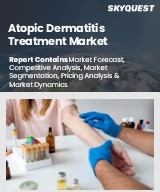
세계의 아토피 피부염 치료 시장 규모는 2023년에 172억 달러로 평가되며, 2024년에는 186억 달러, 2032년에는 352억 달러로 성장하며, 예측 기간(2025-2032년)의 CAGR은 8.3%로 성장할 전망입니다.
세계의 아토피 피부염 치료제 시장은 유병률 증가와 조기 진단에 대한 환자 인식이 높아지면서 큰 성장을 달성하고 있습니다. 이러한 수요의 급증은 표적 생물제제, 면역 경로를 정밀하게 조절하는 저분자 억제제 등 치료법의 발전으로 이어지고 있습니다. 기존 주사제에 도전하는 경구용 약물 등 혁신적인 치료법으로 환자들의 선택의 폭이 넓어지고 있습니다. 처방에 의한 치료와 디지털 헬스 솔루션을 결합한 개인 맞춤형 치료 계획과 통합 의료를 지향하는 경향이 두드러집니다. 생명공학 기업은 다양한 환자들의 요구에 부응하기 위해 선택적 야누스 키나아제 억제제 및 차세대 생물제제 개발에 집중하고 있습니다. 또한 주요 기업 간의 전략적 인수합병은 혁신을 강화하고, 원격 피부과 서비스 확대와 리얼월드 증거에 대한 노력은 환자 모니터링과 임상적 의사결정을 개선하고 있습니다.
Global Atopic Dermatitis Treatment Market Size was valued at USD 17.2 Billion in 2023 poised to grow between USD 18.6 Billion in 2024 to USD 35.2 Billion by 2032, growing at a CAGR of 8.3% in the forecast period (2025-2032).
The global atopic dermatitis treatment market is experiencing significant growth due to the rising incidence of the condition and increasing patient awareness leading to early diagnoses. This surge in demand has led to advancements in therapies, including targeted biologics and small-molecule inhibitors that precisely modulate immune pathways. Innovative treatments, such as oral medications that challenge traditional injectables, are diversifying patient options. There is a notable trend towards personalized treatment plans and integrated care, combining prescription therapies with digital health solutions. Biotech companies are focused on developing selective Janus kinase inhibitors and next-generation biologics to meet varied patient needs. Additionally, strategic acquisitions among key players are enhancing innovation, while expanding teledermatology services and real-world evidence initiatives are improving patient monitoring and clinical decision-making.
Top-down and bottom-up approaches were used to estimate and validate the size of the Global Atopic Dermatitis Treatment market and to estimate the size of various other dependent submarkets. The research methodology used to estimate the market size includes the following details: The key players in the market were identified through secondary research, and their market shares in the respective regions were determined through primary and secondary research. This entire procedure includes the study of the annual and financial reports of the top market players and extensive interviews for key insights from industry leaders such as CEOs, VPs, directors, and marketing executives. All percentage shares split, and breakdowns were determined using secondary sources and verified through Primary sources. All possible parameters that affect the markets covered in this research study have been accounted for, viewed in extensive detail, verified through primary research, and analyzed to get the final quantitative and qualitative data.
Global Atopic Dermatitis Treatment Market Segments Analysis
The global atopic dermatitis treatment market is segmented based on treatment type, age group, severity, and region. In terms of treatment type, the market is divided into topical treatments, systemic treatments, phototherapy, and biologics. Based on age group, the market is trifurcated into pediatric, adult and geriatric. Based on severity, the market is grouped into mild, moderate, and severe. Based on region, the market is segmented into North America, Europe, Asia-Pacific, Central & South America and the Middle East & Africa.
Driver of the Global Atopic Dermatitis Treatment Market
The increasing accessibility of biologic therapies that specifically target immune pathways has transformed the management of moderate to severe atopic dermatitis. These innovative treatments effectively decrease the frequency and severity of flare-ups by regulating interleukin activity and other inflammatory responses. With their extended duration of effectiveness and minimized systemic side effects, they enhance disease control, leading to improved patient outcomes. This, in turn, encourages wider adoption of these therapies in various clinical environments, driving significant growth in the global atopic dermatitis treatment market. The positive impact of these advancements is pivotal for patients seeking effective long-term relief from this chronic condition.
Restraints in the Global Atopic Dermatitis Treatment Market
The Global Atopic Dermatitis Treatment market faces significant challenges due to the high costs associated with advanced therapies, which render them inaccessible for many patients. Even in well-resourced healthcare systems, payers frequently restrict coverage to only severe cases, creating additional hurdles for those in need. These financial barriers can impede the start of necessary treatments, lead to delays in therapy initiation, and ultimately slow down the overall development of the treatment market in both established and emerging economies. As a result, the potential for effective care remains limited, impacting patient outcomes and satisfaction.
Market Trends of the Global Atopic Dermatitis Treatment Market
The Global Atopic Dermatitis Treatment market is witnessing a notable shift towards precision immunotherapies, tailoring treatment pathways to target specific inflammatory mechanisms. This evolution includes the advancement of biologics that inhibit inflammatory interleukins and the emerging small molecule JAK inhibitors, which are transitioning from clinical trials to real-world applications. Such innovations enhance the clinician's ability to personalize therapies, aligning them with individual patient profiles and varying degrees of disease severity. As healthcare providers increasingly adopt these targeted approaches, the market is expected to grow significantly, driven by the demand for more effective, individualized treatment options in managing atopic dermatitis.